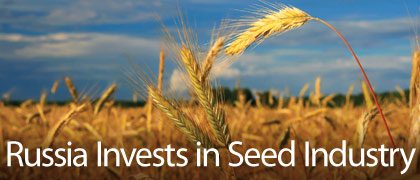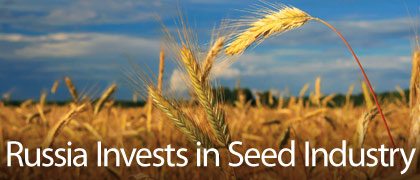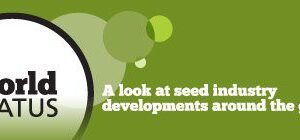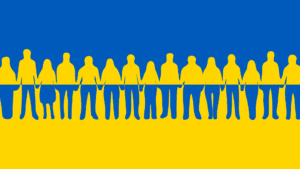
Russia plans to raise the seed industry out of a protracted crisis through investment — to the tune of $9.4 billion — in breeding, research and infrastructure with an aim to increase yields and profitability.
After the collapse of the Soviet Union, for a long time the seed industry in Russia did not develop, mostly due to the absence of state support. This lack of investment in the seed industry led to deteriorating infrastructure, with almost 90 per cent of the main assets within the industry becoming eroded. According to experts at the Russian Ministry of Agriculture’s Seed Department, this problem began in the early 2000s, due to deterioration of the material and technological base of the seed selection process, declining seed production and the lack of adequate infrastructure. As a result, low quality seeds make up 30 per cent of the domestic seed supply.
Under such conditions, crop varieties are only able to realize 30 per cent of their yield potential, according to official estimates. Independent experts peg this figure even lower — at 15 per cent. Despite this, Russia has set its sights on doubling the yields of its main agricultural products by 2030. In particular, the government aims to increase cereal yield up to 150 million tonnes, but authorities confirm that without further development of the seed industry, this goal will be impossible to realize. Therefore, the government has recently adopted a long-term program to develop the Russian seed industry, which is outlined in the paper entitled The Strategy of Selection and Seed Industry Development through 2020. Through this program, the Russian government plans to invest $8.9 billion to develop a scientific and commercial foundation for the seed industry.
Stake in Science
Presently, variety selection in the Russian Federation is mainly represented by breeding centres of the Russian Agricultural Academy. There are few non-state selection centres in the country, and these are usually the departments of large seed companies.
Russia operates 42 agricultural breeding centres, which develop 300 to 400 new varieties and hybrids of agricultural plants each year. According to official statistics from 1991 to 2013, it was recorded in the State Register of Breeding Achievements that 1614 varieties and hybrids of various agricultural crops and other products were developed. However, as Table 1 indicates, the distribution of breeding centres in Russia is extremely uneven; thus, the government plans to spend $2.7 billion on the development of a scientific foundation for the seed industry, with the number of breeding centres to be increased by 50 per cent by 2020.
Table 1. Scientific Russian Federation Support of Breeding and Seed Production
| Name of Federal District | Number of Breeding Centres/Units | Dominant Cultures |
| Central | 13 | Grains, legumes, cereals, vegetables, oilseeds, flax, canola, sugar beets, fruit, berries, feed |
| Northwest | 1 | Grains, potatoes, canola, feed |
| South and North Caucasus | 11 | Grains, legumes, corn, rice, oilseeds, fruit, grapes, feed |
| Volga | 6 | Grains, corn, cereals, oilseeds, flax, potatoes, fruit, feed |
| Uralian | 3 | Grains, peas, potatoes, fruit, berries, feed |
| Siberian | 6 | Grains, cereals, legumes, potatoes, fruit, vegetables, berries, feed |
| Far Eastern | 2 | Soybeans, grains, vegetables, potatoes, berries, fruit, feed |
Source: The Strategy of Selection and Seed Industry Development through 2020
Major Investment in Business Development
Under the program, about $6.7 billion will also be invested to support businesses operating in the seed industry.
According to the paper, the money spent on research activity into crop breeding should increase by 28 per cent by 2018 and 30 per cent by 2020 (when compared with the average level of expenditures from 2006 to 2010), with a projected increase in the proportion of non-budgetary funds by 32 per cent in 2018 and 45 per cent in 2020.
In parallel, the government plans to increase patents through the creation of new varieties, with an increase of up to 35 per cent in 2018 and 45 per cent in 2020 in breeding facility assets.
Increase Innovation
Another priority is increasing the level of innovation in small businesses, thereby increasing the number of small-scale breeding and innovative seed companies by 30 units in 2013, 50 units in 2018 and 60 units in 2020. The government also forecasts that with state support, investment attractiveness as well as profitability of seed businesses will grow significantly compared with current levels.
Increased Quality and Production
All of these measures should result in a dramatic increase in the domestic production of quality seed for agricultural producers. The goal is to have enough Russian-produced seed to meet 70 per cent of demand by 2018 and 75 per cent by 2020. The main assets of the industry are also expected to increase by 80 per cent by 2018 and 90 per cent by 2020.
Table 2. Program Implementation Results
| Total Units/Personnel 2011-2013 | Total Units/Personnel 2014-2018 | Total Units/Personnel 2019-2020 | Totals 2011-2020 | |
| Development of modern biotechnology and new breeding methods (units) | 40 | 96 | 60 | 196 |
| Creation of modern varieties and hybrids (units) | 680 | 916 | 354 | 1950 |
| Development of modern technologies for cultivation of crops (units) | 24 | 26 | 45 | 95 |
| Training of scientific personnel (persons) | 200 | 470 | 150 | 820 |
| Including doctors (persons) | 22 | 25 | 26 | 73 |
| Including PhD candidates (persons) | 178 | 220 | 224 | 622 |
Source: The Strategy of Selection and Seed Industry Development through 2020
Boosting Productivity
According to Russia Ministry of Agriculture forecasts, these investments should promote the rapid development of crop production in Russia and lead to a significant increase in crop yields. In particular, it is expected that cereal yield should rise by 70 per cent. For the Russian government, it is very important that investments are characterized by high returns; for example, every dollar that is invested should return almost seven dollars to the state. The realization of the program in increased production of agricultural products should generate $66 billion for the state budget and significantly increase the profitability and competitiveness of Russia’s seed producers.
Vladislav Vorotnikov













